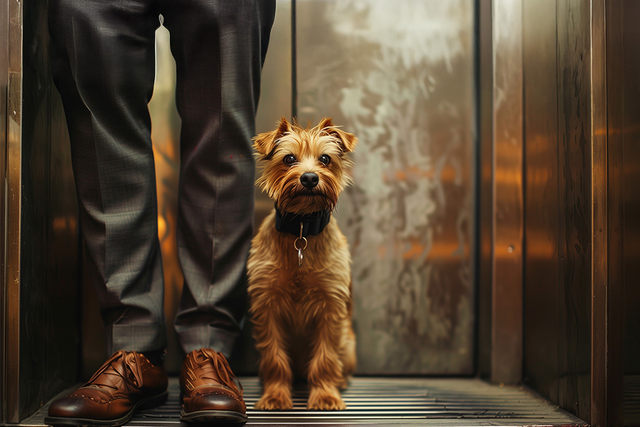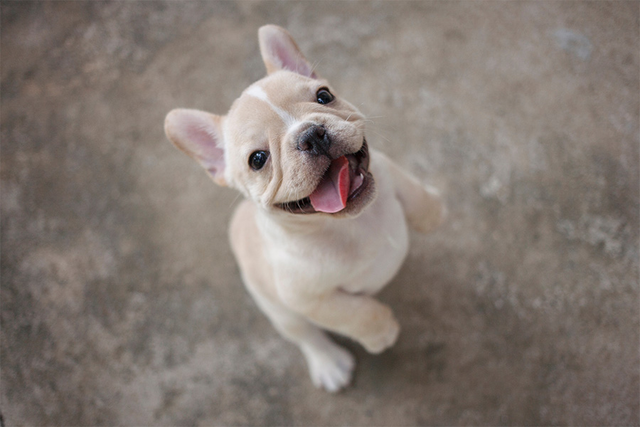Mess-Free Pee Pad Training for Male Dogs

Male dog pee pads are a game-changer for many pet owners. They offer a practical solution for house training and indoor bathroom needs.
Male dogs are known to lift their leg which can bring challenges when it comes to dog training pads if they are not set up for success.
And - by success, we mean vertically so they can catch everything possible. But how do you maintain these pee pads effectively? Dealing with behavioural issues and transitioning to outdoor training is also top of mind when training a new male puppy.
Understanding Male Dog Pee Pads
Male dog pee pads serve a unique purpose in pet care. They are designed to absorb and contain your dog's urine efficiently. These pads are particularly important for dogs that need an indoor bathroom solution.
For homes where outdoor access is limited, they provide convenience and cleanliness. Choosing the appropriate pee pad is essential for achieving the best results.
These pads are made from various materials, offering different levels of absorbency and features. Some are disposable, while others are washable. Selecting the right type helps ensure proper usage and hygiene.
Choosing the Right Pee Pad
Selecting the perfect pee pad involves evaluating your dog's needs. Consider factors like size, absorbency, and cost. It's crucial to match the pad size with your dog's size to avoid messy overflows. Check if the pee pad has features that fit your living situation.
Opt for high absorbency for less frequent changes. Reusable pads may save money over time. Eco-friendly options reduce environmental impact. Such considerations will guide you in making the best choice.
Balancing these factors ensures a happier, cleaner home for both you and your dog.
Vertical pee pads for Male Leg Lifters
When it comes to addressing the needs of male dogs that tend to lift their leg when relieving themselves, finding the right solution can make all the difference for pet owners. Vertical pee pads specifically designed for these energetic pups offer a practical and effective way to manage indoor bathroom habits.
These pads feature a unique design that allows for easy use, minimizing mess and providing a designated area for your dog. By catering to their natural instincts, these vertical puppy training pads can make the experience more comfortable and less stressful for both the pet and the owner.
-
Incorporating vertical pee pads with a pee pad holder into your dog's routine can bring about several advantages. For one, these specially designed pads can help protect your floors and furniture from accidents, ultimately saving you time and effort in clean-up. Additionally, they can serve as a helpful training tool, guiding your dog to the appropriate place for bathroom use and reinforcing desired behaviour.
-
The convenience of these pads is especially valuable for those living in apartments or homes without direct access to outdoor spaces, allowing for flexibility while still maintaining a clean living environment.
Furthermore, choosing the right vertical pee pads for dogs can be an essential part of ensuring your dog's overall well-being. Many options are available, made from durable, absorbent materials that help control odour and moisture. Some pads even feature attractant scents to encourage your dog to use them.
By selecting high-quality products that prioritize comfort and functionality, you can enhance your pet's experience while also making your life as a pet owner easier. Ultimately, vertical pee pads can be a smart investment for any household with male dogs who are inclined to lift their leg, making the indoor bathroom experience smoother and more manageable.
The Benefits of Male-Specific Pee Pads
Male-specific pee pads cater to the unique anatomy and behaviour of male dogs. They often come with enhanced absorbency and design features that prevent splashes. These pads can make training and daily use more effective.
Additionally, they help in controlling odour and maintaining a sanitary environment. Dogs feel more comfortable using pads tailored to their needs. As a result, they adapt quicker, making house training easier and more efficient.
Introducing Your Dog to Pee Pads
Getting your dog to use pee pads might require patience and strategy. Start by placing the pad in a quiet, low-traffic area. This helps your dog focus without distractions. Consistently guide your dog to the pee pad throughout the day.
Observe your dog’s behaviour for signs they need to go. When you notice these signs, lead them to the pad right away. Praise your dog lavishly when they use the pad correctly. This encourages repeated use and builds a positive association.
Consider setting a schedule that aligns with your dog's habits. Routine reinforces behaviour, making the transition smoother. With time, your dog will learn that the pad is their indoor restroom spot.
Positive Reinforcement Training
Positive reinforcement is key to successful pee pad training. Rewarding your dog for correct behaviour enhances their learning process. Start by offering treats or affection each time they use the pad correctly.
Make sure the praise is immediate and enthusiastic. This ensures your dog clearly connects the behaviour with the reward. Positive reinforcement builds confidence and encourages continued success. Patience is crucial, as consistency in rewards will lead to lasting habits.
Using Scent Attractants
Scent attractants can be effective for training. These substances draw dogs to the pee pad. Many pads come pre-scented to appeal to a dog’s senses.
Consider lightly spraying a scent attractant on the pad if needed. This can guide your dog to the target area. Always choose safe products specifically designed for dog use. These attractants help reinforce the idea that the pad is the right spot to urinate.
Placement and Security of Pee Pads
Positioning pee pads strategically is crucial for effectiveness. Select a spot your dog visits often to increase the likelihood of usage. Ensure it is away from their food and sleeping areas, as dogs prefer separate spaces.
Consider using a holder or tray to keep the pad in place. This prevents sliding and adds stability. A well-secured pad reduces mess and stress for both you and your dog.
Changing locations too frequently can confuse your dog. Consistency in placement helps reinforce the pad as the intended bathroom area.

Securing Pee Pads in Place
Securing pee pads properly is essential to avoid accidents. Use a pee pad holder or adhesive strips to keep the pad from shifting. This prevents spills and keeps the area tidy. The Doggy Bathroom can be the ideal solution since it was specifically created for male dogs who lift their leg.
Doggy Bathroom Pee Pads are outfitted with an adhesive strip to secure them vertically inside the Doggy Bathroom making life for you and your dog more comfortable and secure.
Anchoring your pad also makes clean-up easier. Sturdy placement reassures your dog, making them more likely to use the pad consistently. Proper security is a small but crucial step for successful training.
Ideal Locations for Pee Pads
Choosing the right location for pee pads can make training simpler. Look for areas where your dog typically urinates. High-traffic zones might not be ideal, as they can distract or disturb your dog.
Ensure the location is easily accessible at all times. Avoid cramped spaces or areas where the pad might go unnoticed. This thoughtful placement encourages consistent usage and reduces stress for both pet and owner.
Maintenance and Hygiene
Proper maintenance and hygiene are vital for a clean environment. Routine checks prevent odours and ensure health for you and your pet. Keeping pee pads fresh also prolongs their effectiveness.
Regularly clean the area surrounding the pad. This discourages your dog from choosing alternative spots. Vigilance in cleaning habits keeps your home smelling fresh and welcoming.
Consider using air fresheners or odour-neutralisers. These can mask any lingering smells. A clean area encourages your dog to continue using the pee pad properly.
Cleaning and Disposal
Proper cleaning and disposal of used pee pads are essential for controlling odours and maintaining a hygienic environment. After each use, fold the pad inward to contain the waste before discarding it responsibly. This simple step minimises bacterial growth and ensures a clean, fresh space.
Be sure to clean the floor beneath the pad regularly. Wipe the area with a pet-safe cleaner after each pad change to prevent lingering smells and maintain a healthy environment for your dog.
The Doggy Bathroom provides an innovative solution to simplify this process. Its thoughtfully designed receptacle keeps everything contained in one easy-to-clean space, reducing mess and hassle. The specially crafted pee pads, capable of holding up to 1000 mL, allow for multiple uses before needing replacement—making it both practical and efficient.
Changing Frequency and Signs of Wear
Monitor the pee pad for signs of wear. Pads with visible saturation should be changed to prevent leaks. Replace them even if your dog hasn't used every inch of the pad.
Recognise the frequency with which your dog uses the pad. This helps predict when changes are necessary. Consistent changing prevents undesirable behaviours like seeking alternative spots in your home.
Advanced Tips for Pee Pad Training
Enhancing your dog's pee pad training involves more than basic setups. Introducing structured routines is crucial. This structure assists your dog in understanding expectations.
Patience is key during training. Remain consistent with your approach and timeframe. Dogs respond best to predictable schedules.
Additionally, providing clear commands can solidify success. Your dog learns to associate specific words with actions. This can create a stronger habit of using the pads correctly. Read more about Pee Pad Training here: A Step-by-Step Guide to Effective Dog House Training
Dealing with Behavioural Issues
Behavioural issues may arise during pee pad training. Address these immediately to prevent long-term habits from forming. Some dogs may shred pads or ignore them completely.
To discourage shredding, try using pad holders. These can secure the pad, making it less inviting to chew. If your dog ignores the pad, consult a professional for guidance.
Remember, never punish mistakes. Instead, focus on positive reinforcement to encourage the correct behaviour.
Transitioning to Outdoor Training
Transitioning to outdoor potty habits is achievable with gradual steps. Start by moving the pee pad closer to the door. This signals to your dog that outside is an option.
Once they're comfortable, take the pads outside temporarily. Reinforce this new setup with treats and praise. This creates a positive link between outdoor space and potty time.
Patience is essential here. Every dog transitions at its own pace; celebrate small victories along the way.
Environmental and Health Considerations
Choosing eco-friendly options helps reduce your carbon footprint. Consider reusable pee pads. They are not only environmentally responsible but also cost-effective over time.
Monitor your dog's health through pad usage. Noticing changes in urination habits can provide early health warnings. Observing pad use helps track any potential issues quickly.
Eco-Friendly and Washable Options
Eco-friendly pee pads often include biodegradable materials. These break down quickly and leave minimal waste. Washable pads offer another sustainable choice.
They provide a durable alternative, reducing frequent purchases. Wash and reuse these pads, making them both practical and economical. Investing in these options supports green living while maintaining convenience.
Monitoring Health Through Pee Pad Usage
Pee pads can reveal insights into your dog’s health. Keep an eye on the urine's colour and frequency. Changes might indicate medical issues that need attention.
Observing these can alert you to visit a vet. Early detection can be crucial for prevention and treatment. Always stay proactive about your pet's health and well-being.
The Role of Consistency and Routine
Consistency is key for successful pee pad training. Establish a routine for your dog. This helps reinforce positive habits and reduces accidents.
Regularly place the pads in the same spot. This creates a familiar space for your pet. Routine builds confidence and reliability in using the pads.
Maintain patience and stay committed to the process. A steady approach ensures long-term success and a happier household.






